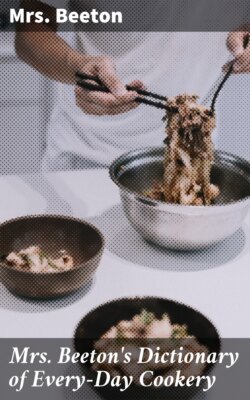Читать книгу Mrs. Beeton's Dictionary of Every-Day Cookery - Mrs. Beeton - Страница 180
На сайте Литреса книга снята с продажи.
ОглавлениеCOTTAGE LOAF.
If either the sponge or the dough be permitted to overwork itself, that is to say, if the mixing and kneading be neglected when it has reached the proper point for either, sour bread will probably be the consequence in warm weather, and bad bread in any. The goodness will also be endangered by placing it so near the fire as to make any part of it hot, instead of maintaining the gentle and equal degree of heat required for its due fermentation.
Milk or Butter.—Milk which is not perfectly sweet will not only injure the flavour of the bread, but, in sultry weather, will often cause it to be quite uneatable; yet either of them, if fresh and good, will materially improve its quality.
To keep bread sweet and fresh, as soon as it is cold it should be put into a clean earthen pan, with a cover to it: this pan should be placed at a little distance from the ground, to allow a current of air to pass underneath. Some persons prefer keeping bread on clean wooden shelves without being covered, that the crust may not soften. Stale bread may be freshened by warming it through in a gentle oven. Stale pastry, cakes, &c., may also be improved by this method.
COTTAGE LOAF.
The utensils required for making bread on a moderate scale, are a kneading-trough or pan, sufficiently large that the dough may be kneaded freely without throwing the flour over the edges, and also to allow for its rising; a hair sieve for straining yeast, and one or two strong spoons.
Yeast must always be good of its kind, and in a fitting state to produce ready and proper fermentation. Yeast of strong beer or ale produces more effect than that of milder kinds; and the fresher the yeast, the smaller the quantity will be required to raise the dough.
As a general rule, the oven for baking bread should be rather quick, and the heat so regulated as to penetrate the dough without hardening the outside. The oven door should not be opened after the bread is put in until the dough is set, or has become firm, as the cool air admitted, will have an unfavourable effect on it.
Brick ovens are generally considered the best adapted for baking bread: these should be heated with wood faggots, and then swept and mopped out, to cleanse them for the reception of the bread. Iron ovens are more difficult to manage, being apt to burn the surface of the bread before the middle is baked. To remedy this, a few clean bricks should be set at the bottom of the oven, close together, to receive the tins of bread. In many modern stoves the ovens are so much improved that they bake admirably; and they can always be brought to the required temperature, when it is higher than is needed, by leaving the door open for a time.
TIN BREAD.
